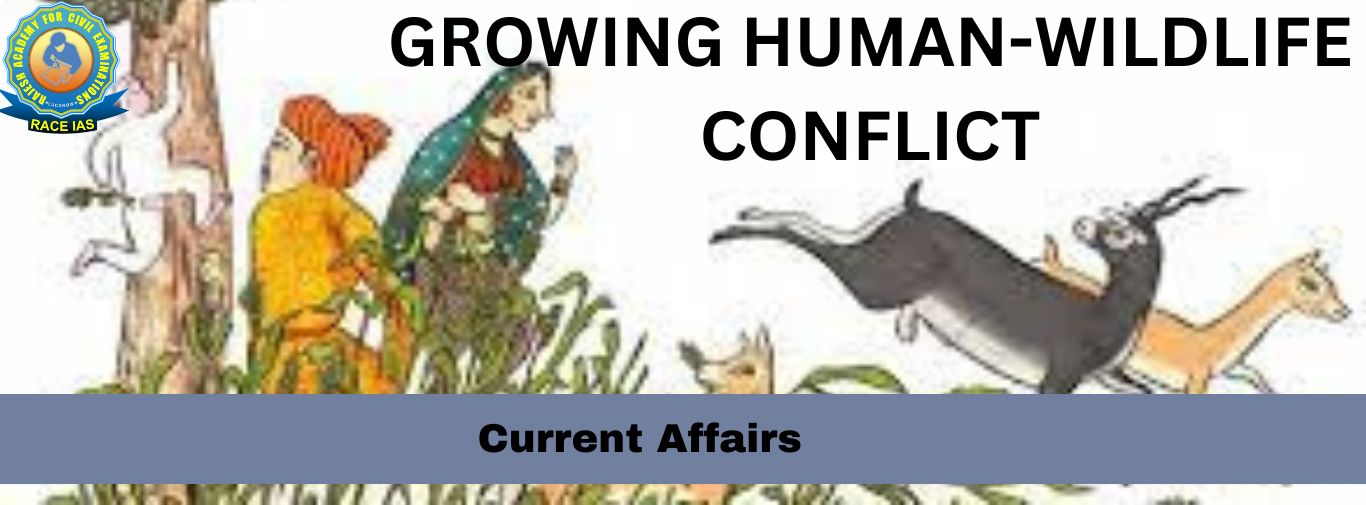
GROWING HUMAN-WILDLIFE CONFLICT
GROWING HUMAN-WILDLIFE CONFLICT
Reference:
- In the recent times, the situation of human-wildlife conflict is getting serious in many states including Uttarakhand.
Central government statistics show that,
- In 20 years, 86 people have been killed by leopards, while 351 people have been injured in wild animal attacks.
- In hilly areas, wild boar and cockerel, langur and monkeys have damaged 43 percent of agriculture.
- Due to illegal deforestation in forest areas, the attack of wild animals is increasing rapidly in rural and surrounding areas.
- Wild life is safe in the forests but due to the increasing number of wildlife, the people of the rural areas located around the forests are not safe due to the ever increasing attacks of wild animals.
- In Uttarakhand, Rajaji National Park and Jim Corbett Park being Tiger Reserve are the largest concentration of wild elephants. There is not enough food for elephants, leopards and other wildlife in the forests. That's why human-wildlife conflict is increasing.
- Tigers are doing 70 percent of the attacks in human-wildlife conflict every year.
- The area of forests is continuously decreasing and there is no fodder for elephants in the forests. Due to this, elephants are turning towards human-dominated villages and are continuously destroying their crops. In such a situation, human-wildlife conflict also starts increasing.
Human-Wildlife Conflict:
- The situation of conflict between both wildlife and humans for protection and livelihood is called 'human-wildlife conflict'.
- All negative effects on humans, wildlife, society, economic sector, cultural life, wildlife conservation or environment due to any kind of contact between humans and wildlife come under the category of human-wildlife conflict.
Causes of Human-Wildlife Conflict:
- More expansion in agriculture related activities.
- Excessive urbanization.
- Recurrence of climate change related factors.
- Rapidly growing infrastructural development.
- Huge increase in the number of wildlife.
Effects of Human-Wildlife Conflict:
- Reduction in the production capacity of agriculture
- Migration of people to cities due to low yield in hilly areas.
- Increasing sense of insecurity among people in villages adjacent to forests.
- seriously endangering the lives of people.
- Increase in violence against animals.
- According to the Union Ministry of Environment, Forest and Climate Change, between 2014-2015 and 2018-2019, more than 500 elephants died due to human-elephant conflict.
- During these same years, 2,361 people were killed as a result of conflicts with elephants.
Efforts to prevent Human-Wildlife Conflict:
- Human-wildlife conflict has been recognized as a global concern in the post-2020 Global Biodiversity Framework at the United Nations Convention on Biological Diversity.
- Governments are working on formulation and implementation of national policies to control human-wildlife conflict.
- The Standing Committee of the National Board for Wildlife has approved the management of human-wildlife conflict in the country.
- The Wildlife Protection Act, 1972 has empowered Gram Panchayats to deal with wildlife.
- Provision has been made for compensation under Pradhan Mantri Fasal Bima Yojana for loss of crops due to human and wildlife conflict.
Conclusion:
- India is the country most affected by human-wildlife conflict. Because India is home to the world's second largest human population and also a large number of tigers, Asian elephants, one horned rhinoceros, Asiatic lions and other species are also found in India.
- Certainly, wildlife conservation is not only very important, but also an environmental imperative, but it is also true that the shrinking forests are not enough to provide complete habitat to the wildlife. As long as forests continue to be cut, human-wildlife conflict will continue to increase. In such a situation, the best option to avoid conflict is environment-friendly development, that is, to make such policies so that both humans and wildlife are safe.
------------------------------------------------------------------------------------------